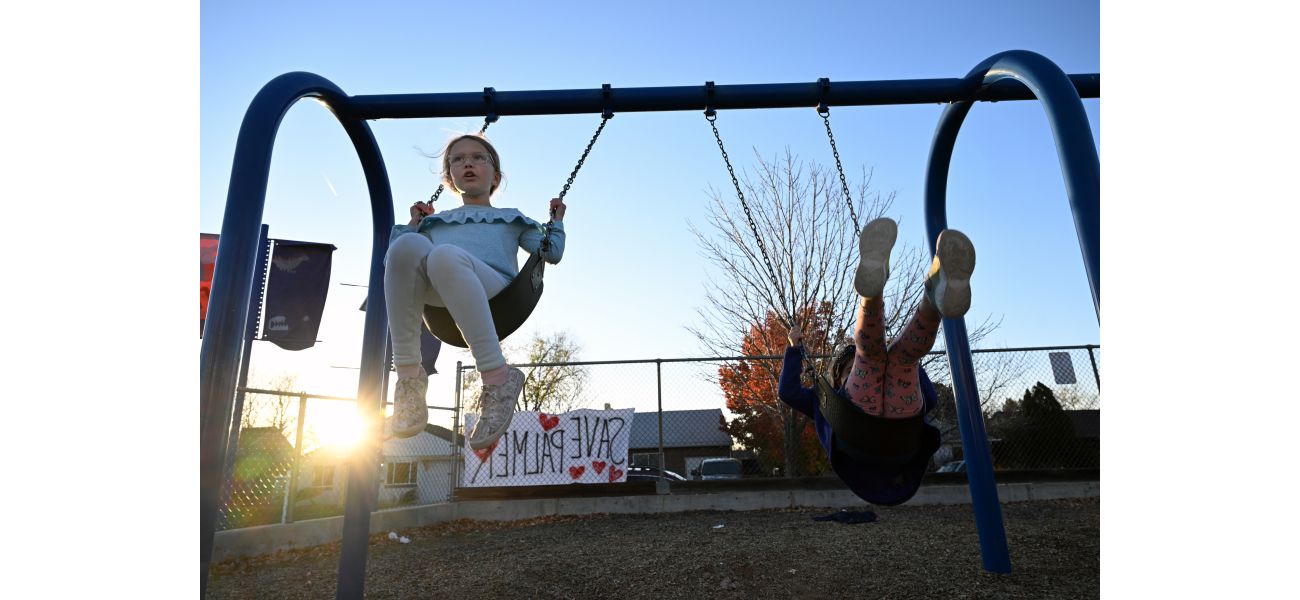DPS selected 10 schools to close or restructure based on certain criteria.
The superintendent presented the consolidation as part of DPS's response to declining enrollment and to avoid a major crisis.
November 9th 2024.

Superintendent Alex Marrero had a difficult decision to make regarding the future of Denver schools. After taking into consideration enrollment numbers, building usage, and the number of families choosing to send their children to schools outside of their neighborhood, Marrero presented his consolidation plan to the Denver Public Schools Board of Education. The plan, which was presented during a meeting on Thursday evening, proposed the closure or restructuring of 10 schools by the end of the academic year.
During the meeting, board President Carrie Olson acknowledged the difficulty of the situation, stating that none of them wanted to see schools close. The school board is set to vote on the closure of seven schools on November 21, while Marrero has the authority to restructure the remaining three without board approval. The superintendent explained that the consolidation was part of the district's response to declining enrollment, which has resulted in a substantial loss of state funding.
Marrero's decision was based on specific criteria, including the building's capacity usage, sustainable enrollment levels, and the number of families within a school's boundaries choosing to send their children elsewhere. He also proposed the use of new or expanded enrollment zones, which would allow families to choose from multiple schools rather than being limited to their neighborhood school.
The 10 schools on Marrero's list for closure or restructuring were Castro Elementary, Columbian Elementary, Denver School of Innovation and Sustainable Design, International Academy of Denver at Harrington, Palmer Elementary, and Schmitt Elementary. Each school was recommended for different reasons, and the superintendent's plan outlined the options for students if their school were to close.
Castro Elementary, located on Lowell Boulevard, was proposed for closure due to low enrollment and building usage. With only 237 students enrolled and a building capacity of 39%, many families within the school's boundaries are choosing to send their children to other schools in the district. If Castro were to close, students would have the option to attend either Knapp Elementary or CMS Community School.
Columbian Elementary, located on W. 40th Street, has a similar situation with low enrollment and building usage. With only 20 kindergarteners enrolled out of a total of 143 students, the school is only at 38% capacity. If Columbian were to close, students would be guaranteed a seat and transportation to a new enrollment zone in northwest Denver, which includes Beach Court Elementary, Centennial: A School for Expeditionary Learning, Edison Elementary, and Trevista at Horace Mann. The school's special education program would also move to Trevista.
The Denver School of Innovation and Sustainable Design, a high school, would close due to its small enrollment of only 60 students. This enrollment is not considered sustainable, and the school's building usage is at a low 16%. Students who attend this school do not have a designated boundary, so if the school were to close, they would have the option to attend their neighborhood school or one of several schools in a designated enrollment zone.
International Academy of Denver at Harrington, an elementary school, was recommended for closure due to low enrollment and building usage. With only 122 students enrolled and a building capacity of 22%, the school does not have enough kindergarteners to constitute a full class. Students who attend this school would have the option to attend a school in the Greater Five Points/Central Enrollment Zone, which would also receive an expansion to include more schools.
Palmer Elementary, located on Grape Street, was proposed for closure due to low enrollment and building usage. With only 150 students enrolled and a building capacity of 43%, the school has a high number of families choosing to send their children to other schools in the district. If Palmer were to close, students would have the option to attend a school in the newly created Central East Elementary School Zone.
Finally, Schmitt Elementary was recommended for closure due to low enrollment and building usage. With only 177 students enrolled and a building capacity of 22%, the school has a high number of families choosing to send their children to other schools. If Schmitt were to close, students would have the option to attend a school in the newly created Central East Elementary School Zone.
Enrollment figures, building usage, and parental decisions all played a role in the decision of Superintendent Alex Marrero to close or restructure 10 Denver schools. At a recent meeting, Marrero presented his plan to the Board of Education, which included permanent closures or grade level restructurings at the end of the academic year.
During the meeting, Board President Carrie Olson acknowledged the difficulty of the situation, stating that none of them wanted to close schools. The board will vote on closing seven schools on November 21st, while the approval of restructuring for the remaining three schools is not required by the board. Marrero framed the consolidation as part of the district's efforts to address declining enrollment and prevent a financial crisis. With fewer students enrolling in Denver schools, the district is losing millions of dollars in state funding each year.
Marrero's recommendations were based on several criteria, including building capacity, sustainable enrollment levels, and the number of families in a school's neighborhood choosing to send their children elsewhere. His plan relies heavily on the implementation of new or expanded enrollment zones, which allow families to choose from multiple schools instead of being assigned to a single neighborhood school.
The first school on the list for closure is Castro Elementary, which currently utilizes only 39% of its building capacity and has a low enrollment of 237 students. Many families within Castro's boundary have opted to send their children to other schools in the district, with only 41 students choosing to attend Castro despite not living within its boundaries. If Castro closes, students will have the option to attend Knapp Elementary or CMS Community School, both of which offer a Transitional Native Language Instruction program for Spanish-speaking students.
Next is Columbian Elementary, which is operating at only 38% of its building capacity and has a total enrollment of 143 students. With only 20 kindergarteners enrolled, the school falls short of a full class size. Similar to Castro, more families living in Columbian's boundary choose to send their children elsewhere in the district than those who choose to attend the school. If Columbian closes, students will be guaranteed a seat and transportation to a school in a new enrollment zone in northwest Denver. Additionally, Columbian's special education program will move to Trevista at Horace Mann.
The Denver School of Innovation and Sustainable Design, a high school with only 60 total students, including 13 ninth graders, is also recommended for closure. With such a low enrollment, the school is considered unsustainable, and high school enrollment in the area is expected to continue to decline. Furthermore, the school is only using 16% of its building capacity, the lowest among all high schools in the district. As all students at this school are non-residents, if it closes, they will be guaranteed a seat at their neighborhood school or one of several schools within their enrollment zone.
International Academy of Denver at Harrington, an elementary school with 122 students and only 18 kindergarteners, is also on the list for closure. Like the others, this school is only using a small portion of its building capacity and has more families within its boundary choosing to send their children elsewhere than those who choose to attend the school. If it closes, students will be given a seat and transportation to a school in the Greater Five Points/Central Enrollment Zone, which would be expanded to include several additional schools.
Finally, Palmer Elementary, which enrolls 150 students, including 31 kindergarteners, is recommended for closure as well. With a building capacity utilization of 43%, the majority of students living within the boundary attend school elsewhere, while only a small number of students from outside the boundary choose to attend Palmer. If it closes, a new enrollment zone called Central East Elementary School Zone will be created, and students will have the option to attend several different schools.
In conclusion, the decision to close or restructure these 10 Denver schools was not made lightly, and multiple factors were taken into consideration. Superintendent Marrero's plan aims to address declining enrollment and prevent a financial crisis by utilizing new enrollment zones and consolidating underutilized buildings. While this may be a difficult time for the district, the hope is that these changes will ultimately benefit students and families in the long run.
During the meeting, board President Carrie Olson acknowledged the difficulty of the situation, stating that none of them wanted to see schools close. The school board is set to vote on the closure of seven schools on November 21, while Marrero has the authority to restructure the remaining three without board approval. The superintendent explained that the consolidation was part of the district's response to declining enrollment, which has resulted in a substantial loss of state funding.
Marrero's decision was based on specific criteria, including the building's capacity usage, sustainable enrollment levels, and the number of families within a school's boundaries choosing to send their children elsewhere. He also proposed the use of new or expanded enrollment zones, which would allow families to choose from multiple schools rather than being limited to their neighborhood school.
The 10 schools on Marrero's list for closure or restructuring were Castro Elementary, Columbian Elementary, Denver School of Innovation and Sustainable Design, International Academy of Denver at Harrington, Palmer Elementary, and Schmitt Elementary. Each school was recommended for different reasons, and the superintendent's plan outlined the options for students if their school were to close.
Castro Elementary, located on Lowell Boulevard, was proposed for closure due to low enrollment and building usage. With only 237 students enrolled and a building capacity of 39%, many families within the school's boundaries are choosing to send their children to other schools in the district. If Castro were to close, students would have the option to attend either Knapp Elementary or CMS Community School.
Columbian Elementary, located on W. 40th Street, has a similar situation with low enrollment and building usage. With only 20 kindergarteners enrolled out of a total of 143 students, the school is only at 38% capacity. If Columbian were to close, students would be guaranteed a seat and transportation to a new enrollment zone in northwest Denver, which includes Beach Court Elementary, Centennial: A School for Expeditionary Learning, Edison Elementary, and Trevista at Horace Mann. The school's special education program would also move to Trevista.
The Denver School of Innovation and Sustainable Design, a high school, would close due to its small enrollment of only 60 students. This enrollment is not considered sustainable, and the school's building usage is at a low 16%. Students who attend this school do not have a designated boundary, so if the school were to close, they would have the option to attend their neighborhood school or one of several schools in a designated enrollment zone.
International Academy of Denver at Harrington, an elementary school, was recommended for closure due to low enrollment and building usage. With only 122 students enrolled and a building capacity of 22%, the school does not have enough kindergarteners to constitute a full class. Students who attend this school would have the option to attend a school in the Greater Five Points/Central Enrollment Zone, which would also receive an expansion to include more schools.
Palmer Elementary, located on Grape Street, was proposed for closure due to low enrollment and building usage. With only 150 students enrolled and a building capacity of 43%, the school has a high number of families choosing to send their children to other schools in the district. If Palmer were to close, students would have the option to attend a school in the newly created Central East Elementary School Zone.
Finally, Schmitt Elementary was recommended for closure due to low enrollment and building usage. With only 177 students enrolled and a building capacity of 22%, the school has a high number of families choosing to send their children to other schools. If Schmitt were to close, students would have the option to attend a school in the newly created Central East Elementary School Zone.
Enrollment figures, building usage, and parental decisions all played a role in the decision of Superintendent Alex Marrero to close or restructure 10 Denver schools. At a recent meeting, Marrero presented his plan to the Board of Education, which included permanent closures or grade level restructurings at the end of the academic year.
During the meeting, Board President Carrie Olson acknowledged the difficulty of the situation, stating that none of them wanted to close schools. The board will vote on closing seven schools on November 21st, while the approval of restructuring for the remaining three schools is not required by the board. Marrero framed the consolidation as part of the district's efforts to address declining enrollment and prevent a financial crisis. With fewer students enrolling in Denver schools, the district is losing millions of dollars in state funding each year.
Marrero's recommendations were based on several criteria, including building capacity, sustainable enrollment levels, and the number of families in a school's neighborhood choosing to send their children elsewhere. His plan relies heavily on the implementation of new or expanded enrollment zones, which allow families to choose from multiple schools instead of being assigned to a single neighborhood school.
The first school on the list for closure is Castro Elementary, which currently utilizes only 39% of its building capacity and has a low enrollment of 237 students. Many families within Castro's boundary have opted to send their children to other schools in the district, with only 41 students choosing to attend Castro despite not living within its boundaries. If Castro closes, students will have the option to attend Knapp Elementary or CMS Community School, both of which offer a Transitional Native Language Instruction program for Spanish-speaking students.
Next is Columbian Elementary, which is operating at only 38% of its building capacity and has a total enrollment of 143 students. With only 20 kindergarteners enrolled, the school falls short of a full class size. Similar to Castro, more families living in Columbian's boundary choose to send their children elsewhere in the district than those who choose to attend the school. If Columbian closes, students will be guaranteed a seat and transportation to a school in a new enrollment zone in northwest Denver. Additionally, Columbian's special education program will move to Trevista at Horace Mann.
The Denver School of Innovation and Sustainable Design, a high school with only 60 total students, including 13 ninth graders, is also recommended for closure. With such a low enrollment, the school is considered unsustainable, and high school enrollment in the area is expected to continue to decline. Furthermore, the school is only using 16% of its building capacity, the lowest among all high schools in the district. As all students at this school are non-residents, if it closes, they will be guaranteed a seat at their neighborhood school or one of several schools within their enrollment zone.
International Academy of Denver at Harrington, an elementary school with 122 students and only 18 kindergarteners, is also on the list for closure. Like the others, this school is only using a small portion of its building capacity and has more families within its boundary choosing to send their children elsewhere than those who choose to attend the school. If it closes, students will be given a seat and transportation to a school in the Greater Five Points/Central Enrollment Zone, which would be expanded to include several additional schools.
Finally, Palmer Elementary, which enrolls 150 students, including 31 kindergarteners, is recommended for closure as well. With a building capacity utilization of 43%, the majority of students living within the boundary attend school elsewhere, while only a small number of students from outside the boundary choose to attend Palmer. If it closes, a new enrollment zone called Central East Elementary School Zone will be created, and students will have the option to attend several different schools.
In conclusion, the decision to close or restructure these 10 Denver schools was not made lightly, and multiple factors were taken into consideration. Superintendent Marrero's plan aims to address declining enrollment and prevent a financial crisis by utilizing new enrollment zones and consolidating underutilized buildings. While this may be a difficult time for the district, the hope is that these changes will ultimately benefit students and families in the long run.
[This article has been trending online recently and has been generated with AI. Your feed is customized.]
[Generative AI is experimental.]
0
0
Submit Comment





